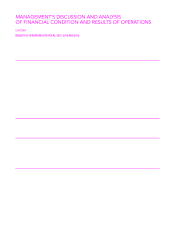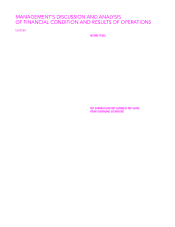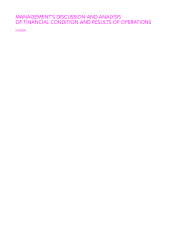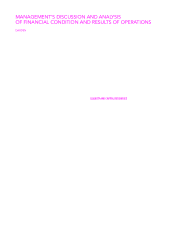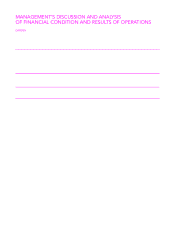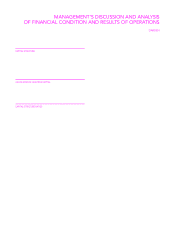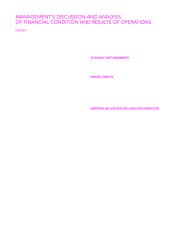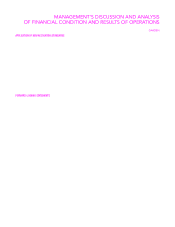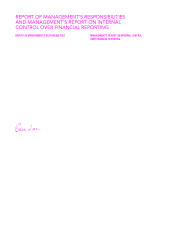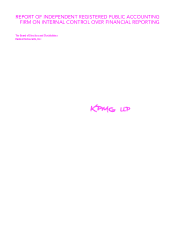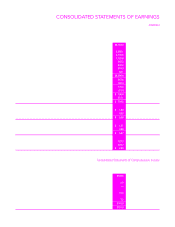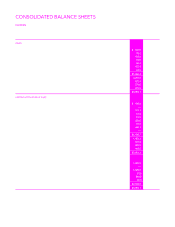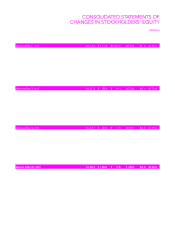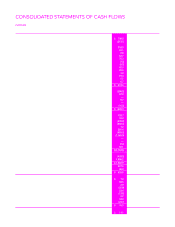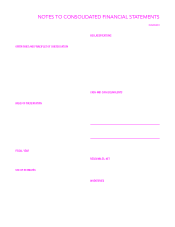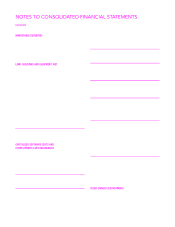Red Lobster 2015 Annual Report Download - page 26
Download and view the complete annual report
Please find page 26 of the 2015 Red Lobster annual report below. You can navigate through the pages in the report by either clicking on the pages listed below, or by using the keyword search tool below to find specific information within the annual report.
22
MANAGEMENT’S DISCUSSION AND ANALYSIS
OF FINANCIAL CONDITION AND RESULTS OF OPERATIONS
DARDEN
In the current year, we reduced our expected rate of return for investment
of pension plan assets from 8.0 percent to 7.0 percent in connection with our
current expectations for long-term returns and target asset fund allocation.
The expected long-term rate of return on plan assets component of our net
periodic benefit cost is calculated based on the market-related value of plan
assets. Currently, our target asset fund allocation is 41.0 percent U.S. equities,
40.0 percent high-quality, long-duration fixed-income securities, 16.0 percent
international equities and 3.0 percent real estate securities. We monitor our
actual asset fund allocation to ensure that it approximates our target allocation
and believe that our long-term asset fund allocation will continue to approxi-
mate our target allocation. In developing our expected rate of return assumption,
we have evaluated the actual historical performance and long-term return
projections of the plan assets, which give consideration to the asset mix and
the anticipated timing of the pension plan outflows. We employ a total return
investment approach whereby a mix of equity and fixed income investments
are used to maximize the long-term return of plan assets for what we consider
a prudent level of risk. Our historical 10-year, 15-year and 20-year rates
of return on plan assets, calculated using the geometric method average
of returns, are approximately 8.3 percent, 7.8 percent and 9.6 percent,
respectively, as of May 31, 2015.
We have a recognized net loss of $68.7 million (net of tax) and a recognized
net gain of $5.9 million (net of tax) as components of accumulated other
comprehensive income (loss) for the defined benefit plans and postretirement
benefit plan, respectively, as of May 31, 2015. These net gains and losses
represent changes in the amount of the projected benefit obligation and plan
assets resulting from differences in the assumptions used and actual experi-
ence. The amortization of the net loss component of our fiscal 2016 net periodic
benefit cost for the defined benefit plans is expected to be approximately
$2.8 million. The amortization of the net gain component of our fiscal 2016
net periodic benefit cost for the postretirement benefit plan is expected to be
approximately $3.8 million.
We believe our defined benefit and postretirement benefit plan
assumptions are appropriate based upon the factors discussed above.
However, other assumptions could also be reasonably applied that could
differ from the assumptions used. A quarter-percentage point change in the
defined benefit plans’ discount rate and the expected long-term rate of return
on plan assets would increase or decrease earnings before income taxes by
$0.0 million and $0.5 million, respectively. A quarter-percentage point change
in our postretirement benefit plan discount rate would increase or decrease
earnings before income taxes by $0.1 million. These changes in assumptions
would not significantly impact our funding requirements. Additionally, as a
result of changing our postretirement benefit plan from a self-insured plan
to a retiree health exchange with a subsidy to eligible participants through a
Health Reimbursement Account (HRA) during fiscal 2015, health care cost
trend rates no longer affect the accumulated postretirement benefit obligation
(APBO) and the aggregate of the service cost and interest cost components
of net periodic postretirement benefit cost. We expect to contribute approxi-
mately $0.4 million to our defined benefit pension plans and approximately
$1.1 million to our postretirement benefit plan during fiscal 2016.
We are not aware of any trends or events that would materially affect our
capital requirements or liquidity. We believe that our internal cash-generating
capabilities, the potential issuance of unsecured debt securities under our shelf
registration statement and short-term commercial paper should be sufficient
to finance our capital expenditures, debt maturities, stock repurchase program
and other operating activities through fiscal 2016.
OFF-BALANCE SHEET ARRANGEMENTS
We are not a party to any off-balance sheet arrangements that have, or are
reasonably likely to have, a current or future material effect on our financial
condition, changes in financial condition, sales or expenses, results of operations,
liquidity, capital expenditures or capital resources.
FINANCIAL CONDITION
Our total current assets were $1.06 billion at May 31, 2015, compared with
$1.98 billion at May 25, 2014. The decrease was primarily due to the decrease
in assets held for sale associated with the sale of Red Lobster partially offset by
an increase in cash and cash equivalents.
Our total current liabilities were $1.20 billion at May 31, 2015, compared
with $1.62 billion at May 25, 2014. The decrease was primarily due to the
repayment of short-term debt and the reduction of liabilities associated with
assets held for sale.
QUANTITATIVE AND QUALITATIVE DISCLOSURES ABOUT MARKET RISK
We are exposed to a variety of market risks, including fluctuations in interest
rates, foreign currency exchange rates, compensation and commodity prices.
To manage this exposure, we periodically enter into interest rate and foreign
currency exchange instruments, equity forwards and commodity instruments
for other than trading purposes (see Notes 1 and 10 to our consolidated
financial statements in this report, incorporated herein by reference).
We use the variance/covariance method to measure value at risk, over
time horizons ranging from one week to one year, at the 95 percent confidence
level. At May 31, 2015, our potential losses in future net earnings resulting
from changes in foreign currency exchange rate instruments, commodity
instruments, equity forwards and floating rate debt interest rate exposures
were approximately $38.2 million over a period of one year (including the
impact of the interest rate swap agreements discussed in Note 10 to our
consolidated financial statements in this report, incorporated herein by
reference). The value at risk from an increase in the fair value of all of our
long-term fixed rate debt, over a period of one year, was approximately
$93.6 million. The fair value of our long-term debt during fiscal 2015 averaged
$1.77 billion, with a high of $2.63 billion and a low of $1.54 billion. Excluding
debt that was extinguished during the year, the fair value of all of our long-term
debt during fiscal 2015 averaged $1.57 billion, with a high of $1.62 billion and
a low of $1.54 billion. Our interest rate risk management objective is to limit
the impact of interest rate changes on earnings and cash flows by targeting an
appropriate mix of variable and fixed rate debt.


